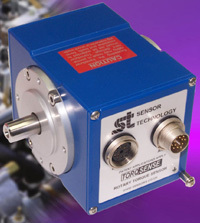
Contact Details:
EngNet - Engineering Network
11121 Carmel Commons Blvd.
Charlotte
NC
28226
United States of America
Tel: +01 704 5413311
Fax: +01 704 9430560
Send Enquiry | Company Information

Mobile harbour equipment can automatically generate commercial information
Product News Wednesday, March 25, 2015: EngNet - Engineering Network
Harbour sides are busy places, with ships docking, unloading one cargo, loading another and departing again as quickly as possible. Keeping track of all this activity and of their various and valuable cargoes is demanding yet vital, so it is best to automate as much as possible. Mark Ingham of Sensor Technology Ltd in the UK explains how the drive shafts of the various machines and mobile plant can instantly generate much of the information needed.
Modern commercial docks are usual awash with machinery, both mobile and static, for loading and unloading ships. The fundamental objective is to handle the cargoes as quickly and efficiently as possible, so that each ship can get back out to sea and its next port of call, and another ship can come in behind it.
In the midst of all this frenetic activity, safety must be maintained, while cargoes must be delivered to the correct location. And of course, the cargoes are valuable so must be protected and precisely accounted for.
The sort of machinery found on quaysides includes wheel loaders, mobile ship unloaders, conveyors, and multiple variants on the humble crane. All of these machines will have one or more rotating drive shafts that transfer power from an electric motor or diesel engine to the working equipment. Each turn of the shaft will progress the equipment’s operation forward or backward a small but consistent amount, and if you can measure the torque (rotational strain) in the shaft you can calculate the weight of cargo being transferred.
This information is useful for several things, such as:
- Safety. An overloaded machine can be dangerous to personnel or could break down and bring operations to a halt
- Operational. Live load data will allow you to calculate the amount of cargo moved, the time to completion of each operation, the number of trucks required for onward shipment, etc.
- Commercial. The value of many cargoes, especially dry bulk materials, is often calculated from its weight, which can be derived from torque figures.
In the past measuring torque has been difficult in the harsh and frantic environment of a busy port, but Sensor Technology has developed a solution that overcomes all the main problems and commercialised it as TorqSense.
The measuring element of TorqSense comprises two small piezoelectric combs called Surface Acoustic Wave devices (SAWs). In use they are simply glued to a drive shaft at 90deg to one another and at +/-45deg to the axis of the shaft. When the shaft rotates one comb expands and the other contracts in proportion to the torque being experienced by the shaft, which alters their resonant frequency.
Thus, if you can measure their resonant frequency, you can calculate the torque. To do this it is natural to think that you would need to wire the combs into a circuit. But because the wires would snap when the shaft rotates another solution is required.
Traditionally this would be done using slip rings, but Sensor Technology has developed a wireless alternative based on radio wave transmissions. A pickup head is mounted near the combs and transmits waves towards them. The waves provide power to the combs (wirelessly!), which reflect the waves back to a receiver in the pickup head. The returning waves have had their frequency altered by the combs – the expanded comb reduces the frequency and the compressed comb increases it.
From these differential signals TorqSense electronics can calculate the torque.
TorqSense is robust, reliable and accurate. It is easy to install, operate and maintain and has built up a loyal following of users. While most people use it in demanding environments, it has many other advantages too; for instance laboratory researchers favour small sized units because they often need to install and remove a sensor multiple times during a series of experiments. With wireless TorqSense this is easy, especially as it does not need to be re-tuned each time it is re-installed. Larger units proved popular with marine applications because they are largely unaffected by the salty atmosphere and constant motion. It can be tuned to measure large or small amounts, so is equally at home measuring coal on a conveyor or metering microscopic amounts of active ingredients into pharmaceuticals.
A variation on the concept is used for measuring load – a straight line equivalent to torque. This is ideal for use on cranes and other dockside equipment where cargo is lifted rather than conveyed. Like its sister technology, LoadSense uses a wireless radio frequency pickup to collect data signals from the sensing head, which can be a variation on piezoelectric combs or a conventional load cell.
Portside operations are increasingly becoming automated. Technologies like TorqSense and LoadSense, while almost completely unobtrusive, are making a vital contribution to improving productivity in line with increasing demand for world trade.
